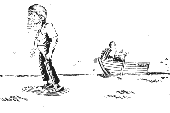 |
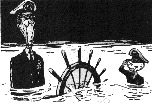 |
| When Jimmy Carter became president, cartoonists showed him as a savior who could walk on water. | When Ronald Reagan became president, cartoonists showed him as taking over a sinking ship. |
Chapter 1 |
TABLE
OF CONTENTS
|
1
From the very beginning, something seemed to be out of control in Reagan's America.
If ever there was a time in history when America should have felt strong and happy, it was at the beginning of the 1980s.
We were not at war. The Iranian hostages had just been returned home safely. There was no domestic violence or major strikes at home. Both economically and militarily, we were the strongest nation on earth, with the highest Gross National Product, the least number of people living in poverty and the highest personal income at any time in our history.
What is more, America had created 20 million new jobs in the past decade and had made major advances in providing for basic nutritional and medical needs for its poorest families, all without any increase in government repression, without major domestic strife and without war.
We had every reason to be proud of what we had accomplished in the 70s and to look forward to the tasks of the 80s secure in the knowledge of our ability to achieve further economic and social progress.
For some reason, however, our success in the previous decade made us feel just terrible. Never before in history had a nation so strong and wealthy felt so weak and impoverished. Ronald Reagan was elected president in what could only be described as an atmosphere of crisis, with the media everywhere filled with predictions of dangers of economic collapse. As he assumed office, our new president voiced what we all felt:
2
we were not strong at all, but "weak and disintegrating." He said he felt like a captain of a ''ship about to go over the falls,'' and that we were ''in
 |
 |
| When Jimmy Carter became president, cartoonists showed him as a savior who could walk on water. | When Ronald Reagan became president, cartoonists showed him as taking over a sinking ship. |
greater danger today than we were the day after Pearl Harbor." We were, in fact, so weak, he said, that we were in danger of being totally impotent before "an evil force that would extinguish the light we've been tending for 6,000 years."
The main reason why we felt we were "about to go over the falls" was said to be our "precarious economic condition." We were supposed to have failed particularly badly in three areas: a "soaring Federal debt," "low corporate investment" and "out of control inflation." Yet actual government figures showed these supposed "failures" were really more fantasy than reality. Federal debt as a percentage of Gross National Product was in fact not soaring but was the lowest in fifty years,(1) corporate investment was not low at all but was in fact the highest since World War II,(2) and even the twelve percent inflation rate at the end of 1980 was coming down fast in the early months of 1981, most of it having been caused by temporary conditions such as the jump in oil prices and higher food prices caused by bad weather.(3)
Yet our healthy economy and enormous military power had little in-fluence on our shared fantasies of growing national impotence and immi-nent danger of disintegration. Polls showed how widespread our fears were: 75 percent of us believed that "the United States had gone off on the wrong track," 60 percent thought we might need a leader who would "bend the rules a bit," and 50 percent felt it might now be necessary to use force to restore "the American Way of Life."(4) Drastic measures of all sorts were seriously discussed by politicians for the first time in decades as ways to restore our depleted strength. The result was the dec-
| .A DARKENING NATIONAL MOOD | 3 |
tion of Ronald Reagan as president, with his radical new "Program for Economic Recovery" and with plans for over a trillion dollars in addi-tional military spending designed to restore our national potency.
The imagery used by the media-imagery which so often reflects our shared feelings-embodied our shared fantasies of impotence and grow-ing anger. Contrary to the normal presidential pattern of an initial "honeymoon period" when the imagery reflects feelings of strength and hopefulness,(5) Ronald Reagan was seen as totally beleaguered by dangerous beasts which he was barely able to hold off with slashing
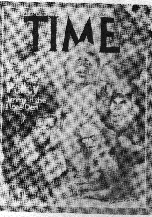 |
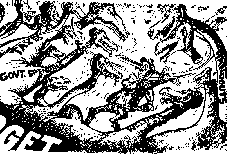 |
| The beasts of the world seemed under our control during Carter's first year. | The beasts of the world seemed out of control as Reagan took over. |
sword strokes. Headline stories at the end of 1980 reported we
felt ourselves to be "AMERICA, A NATION BESET.
IT WAS A YEAR WHEN NATURE SEEMED TO REFLECT A DARKENING
NATIONAL MOOD, WITH THE EXPLOSION OF PENT-UP
FURIES AND A PARCHING OF THE SPIRIT AND
THE LAND."
(N.Y. Times Magazine, emphasis added.)(6)
Ronald Reagan's first speeches, too, reflected our "darkening national mood," our "pent-up furies" and "parching of the spirit." When he won the nomination, he told us that our country was "disintegrating," "weakened" and "eaten away." When he won the election, the most often used word in his acceptance speech was "frightened." In his Inaugural Address, he stressed such words as "terror' (of runaway living costs), "doomed" (what we need not be) and "sacrifice" (what we must now do). His first State of the Nation address consisted almost entirely of such apocalyptic language. If only the
4
sentences which contained emotional terms are reproduced, his entire address reads as follows:
President's State of the Nation Address
February 5, 1981
We're in the worst economic mess since the Great Depression. . .the Federal budget is out of control and we face runaway deficits.. inflation, like radioactivity, was cumulative and that once started it could get out of control... Wars are usually accompanied by inflation.. .we can lecture our children about extravagance until we run out of voice and breath... I've already placed a freeze on hiring.. I've put a freeze on pending regulations... It will propose budget cuts... budget cuts.. spending cuts.. .Prices have exploded. ..We will unleash the energy.. we've let negative economic forces run out of control. We've stalled the judgment day.. .a shattered economy...
Reagan's choice of language was in complete contrast to the State of the Nation addresses of his predecessors. Rather than using the usual "honeymoon period" language reflecting feelings of strength and hope, he confirmed to us our own feelings that our country was "out of control...like radioactivity," and told us we would have to "cut...cut...cut" something or someone to prevent an apocalyptic "judgment day."
To take this one step further, if just the fantasy words (in bold type above) are considered, the essence of his address can be reduced to the following:
Fantasy Analysis of
President's State of the Nation Address
February 5, 1981
| Fantasy Words | Interpretation |
| mess.. .out of control.. .runaway like radioactivity.. .out of control.. .wars. . run out of voice and breath.. freeze.. freeze cuts.. cuts.. cuts.. cuts expended. . unleash.. out of control.. stalled.. .judgment day.. shattered | We feel like a mess, out of control, runaway, like radioactivity. We are so out of control that, as in a war, we are out of breath and freezing. We must cut someone or we'll explode and unleash our out-of-control rage, which, if not stalled now, will produce a final judgment day which will leave us shattered. |
| OUT OF CONTROL | 5 |
These feelings of disintegration and growing rage which we shared at the beginning of Reagan's presidency were not really rational feelings concerning objective economic conditions, as the president claimed. The State of Nation address above says that Federal expenditures, Federal debt and inflation were "out of control" at the beginning of 1981. A look at the actual figures for these three areas shows this to be quite un-true.
First the "runaway" Federal expenditures which we believed to be so out of control had, in fact, shrunk during Jimmy Carter's term as a proportion of Gross National Product,(7) mainly due to Carter's success in keeping military spending under control. (Percentage of GNP rather than absolute dollars is used as the most meaningful index for fiscal analysis, since only in this way can one see the proportion of one's earnings each year that is spent by the government.)
Secondly, the "out of control" Federal debt had in fact also shrunk in the past three decades to one-half the former percentage of GNP. What the Federal government owed was now only equal to 30 percent of a year's pay for each of us compared to 60 percent in 1950 and 110 percent in 1945. Rather than being out of control, Federal debt was actually only now becoming manageable. If we could only avoid huge deficits in the future it would shrink further to a rather insignificant portion of our an-nual earnings.
Thirdly, although the 12 percent average inflation rate at the end of 1980 was indeed higher than in many previous years, it was also true that two days prior to Reagan's State of the Nation address he had just been given the January 1981 inflation figures, which showed that inflation had just dropped to 9 percent. If in fact inflation as Reagan took over was going down-and if lower oil, food and interest costs were forecast by most economists to push the rate still lower in coming months no matter who was in office - then it was pure fantasy to say that inflation at that moment was "out of control like radioactivity."
Yet something seemed to be "out of control like radioactivity" in America. If it wasn't Federal spending, debt or inflation, then perhaps the feeling had something to do with ourselves. Perhaps it was we who for some reason seemed to feel "full of pent-up furies," perhaps it was we ourselves who felt "out of control."
Political commentators intuitively felt the power of this growing na-tional feeling as they summarized the nation's mood at the beginning of Reagan's term. Flora Lewis reported in her N.Y. Times column that "Despite the relaxed banter of the President in news conferences.. .there is a low mean hiss to be heard in the land (as shown by] the snarling, deliberately nasty way people are coming to treat each other, with no immediate provocation but their own despair."(8)
6
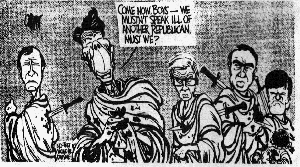
Before Reagan was elected,
he was seen as capable of wielding a knife.
The president himself picked up the angry mood in his language, as when he asked his budget-cutters to be "meaner than junkyard dogs," and in the media imagery of his early months. Rather than the usual "honeymoon" symbols of strength and confidence, the media showed our new leader surrounded by the brutal symbols of the ax, the knife, the hanging rope and the guillotine, accompanied by the murderous phrase "CUT, SLASH, CHOP" endlessly repeated until the emotional message could not possibly be missed.
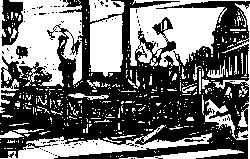
Reagan's inaugural platform was felt to
have been equipped with a guillotine.
"Reagan's ax" was everywhere in the headlines as he took office. Politicians, the media and the public all seemed entranced by the impending violence implied by the thousands of headlines and magazine covers boasting that "REAGAN READIES THE AX,"(9) or "THE AX FALLS"(10) or "REAGAN'S $50B AX! CUTS WILL AFFECT EVERY AMERICAN."(11) Although his "$50 billion cuts" were only in domestic programs, the fantasy was that he had drastically cut the budget.
Political commentators could barely restrain their delight at the coming effects of the sacrificial ax. "The president has brought a wonderful new mood to the federal bureaucracy - fear," said one journalist.(12) Newsweek promised us Reagan's term would be the "bloodiest in years."(13) Reagan himself announced that "the howls of pain will be heard from coast to coast" when what was called his "cut-slash-chop men began their cavalry attacks."(14) Polls showed the public supported his call for pain. As Newsweek put it: "POLLS: LET THE AX FALL."(15)
| THE COMING HOWLS OF PAIN | 7 |
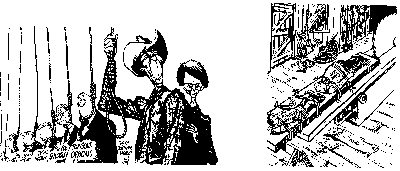
Hanging and cutting people were seen as Reagan's main
tasks.
During the first few weeks of Reagan's presidency, the imagery of the bloody axing of people and their coming howls of pain seemed to be just what we needed to embody our growing rage. Only occasionally could we allow ourselves to feel our guilt about taking out our violent feelings on scapegoats. "Some of what Reagan is doing is great and some of what he's doing just scares me half to death," said one person interviewed, as he wondered how he felt about having voted for Reagan and about the prospect that "a year from now you're going to have people freezing and starving to death."(16) But more often our conscience was easily stilled with economic rationalizations. We usually could barely conceal our praise for what we were asking the Reagan team to do in our name. "I think you've been brilliant," Senator Metzenbaum told David Stockman at an ear-ly Senate Budget Committee hearing. "But I also think you've been cruel, inhumane and unfair."(17) We never questioned why anyone should be praised for being "brilliant" and "cruel" at the same time.
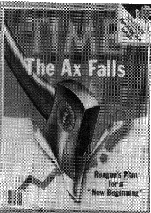
The symbol of Reagan's presidency:
the sacrificial ax.
In the final analysis it was not David Stockman whom we admired for his "brilliant cruelty." It was Ronald Reagan. The same thing was true when we bestowed our praise on others in his administration for their hardness. When columnist George Will praised Alexander Haig for having a "beautifully shining steel fist" in foreign policy, he was in fact
8
also admiring Reagan's beautifully shining hardness. Only a leader that hard, only a president with a shining steel fist, could embody all the rage we asked him to contain for us.
The most important way we asked Reagan to embody our violence was by asking him to effect a military buildup three times as large as that of Vietnam.(18) Despite the fact that the world was unusually peaceful when Reagan took over, polls showed that Americans were nevertheless extremely belligerent in foreign policy at the beginning of 1981. USNews & World Report summed up the nation's feelings in a survey of opinion made in February of 1981 by citing New York City Mayor Ed Koch as saying "Reagan is reflecting the mood of this country. He is exhibiting the fact that the United States will not be pushed around."(19)
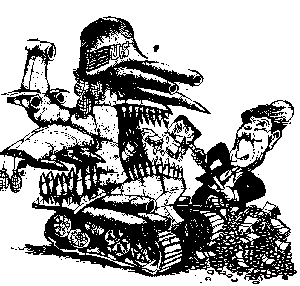
Reagan feeds the military as a container for our violent
fantasies.
The mood behind the new military buildup was openly discussed by the press. "The fevers of war are once again upon us," reported Harper's. "They do not yet rage openly, but beneath the surface of recent American events can be felt the gathering strength of attitudes and emotions that permit us to think about war in ways that were impossible even a year ago. We hear almost daily the militant pronouncements of our political candidates and news of escalating appropriations for arms. We seem to be witnessing the remilitarization of America.. "(20)
Other periodicals repeated the message, with varying degrees of fascination and alarm. The N.Y. Times Magazine featured an article on "RETHINKING THE UNTHINKABLE," with the second headline reading: "After more than a decade during which the idea was all but dismissed, the possibility of nuclear war is again on many people's minds. Some strategists believe it's an option that must not be ruled out-indeed, that such a war can be won. Others fear the entire world will lose." None of the articles tried to show that the new interest in win-ning a nuclear war was brought about by any real change in world conditions. Like the Times, they just noticed that inexplicably "nuclear war is again on many people's minds."
| UNTHINKABLE THOUGHTS | 9 |
The New Republic captured the new mood perfectly in its article on "THE NEW BRINKSMANSHIP":
For the first time since the 1950s, the possibility of nuclear war with the Soviet Union appears to be seriously accepted by key figures inside and outside the US government. what long have been unthinkable thoughts now are entertained by in-fluential men and women in Washington... .A senior white House foreign policy specialist says: "In 30 years, I never thought war was really possible: now l think it is possible... "(22)
It was left up to the women's section of the N.Y. Times to express directly our deepest feelings about "thinking the unthinkable" once again. Maggie Scarf, reviewing the literature on the "increasingly threatening reality" of engaging in atomic war, said simply: "I'm getting scared again."(23)
Ronald Reagan's own feelings about having to embody so much of our explosive anger were ambivalent. Most often, he indicated that as president he completely accepted his role as container for our poisonous rage. As Time reported in their first story on his presidency, at one early meeting "he fingered a jelly bean, and joked: 'They tell me the purple ones are poison,' then nonchalantly popped it into his mouth."(24) His language and actions usually showed him ready to act out our anger and resentment with enthusiasm. Only occasionally did he reveal some guilt and fear of being punished for carrying out his role. "I can assure you, by morning, I'll be hung in effigy," he forecast after an early budget meeting where he proposed slashing funds for the poor and disabled. His fears of punishment, of course, did not come about, since our reaction to his budget cutting was not to hang him in effigy but to praise him openly for his ability to "inflict pain...with nerve and verve."(25)
As Reagan's first month drew to a close, more and more media fantasy messages began to center on the question of whether he was in fact strong enough to be a container for our growing rage. It was as though we felt only a Superman, only a living Man of Steel, could really contain our ex-plosive anger and act it out for us. Was Reagan really strong enough to be the "beautifully shining steel fist" we needed?
Earlier in history, after new kings were crowned, they, too, were often required to prove that they were strong enough to embody their people's violence. Often this was done by having the king engage in a ritual battle with a young warrior to prove his superior strength.(26) Similarly, at the
10
beginning of his term of office, since Ronald Reagan was going to have to embody such an extraordinary amount of our anger, he would have to undergo a trial of his strength if he were to be capable of being our leader in the coming years of "national renewal."
The fantasy that Reagan might die in office surfaced around the country even before his inauguration, in a series of "jokes" arid published speculations, all of which revolved around his age and impending death in office. Most of them were based on the coincidence that no American president elected since 1840 in a year ending in zero had lived out his term of office. "Re-elect Bush in 1984" read one version which appeared on thousands of bumper stickers all over the country, and many other "death jokes" and articles about the "death jinx" multiplied during his first month in office.
The method of his trial was to be by shooting, not hanging, as Reagan himself implied in the phrase quoted earlier. Although death wishes toward a new leader are impossible to portray directly in the media, cartoons often pictured Reagan in conjunction with guns. Some, like the one below, even managed to show him standing next to several targets,
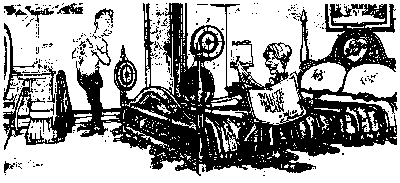
An early cartoon showed Reagan next to targets and guns.
with gun holes all around, and dozens of guns on the floor. Most often - as is usual when the media has to put forth unacceptable fantasy messages - the content of the message was stated openly, but the object was shifted away from Reagan. For instance, when Anthony Lewis labeled his N.Y. Times column at the beginning of 1981 "THE KING MUST DIE," he was overtly writing about Jimmy Carter.(27) Yet his startlingly direct headline, and his discussion of Mary Renault's novel about people who became kings and then are themselves killed, could certainly be taken as an unconscious message that Reagan must die as well. Writing an article headlined "THE KING MUST DIE" just before a Presidential Inauguration could hardly be called a coincidence.
| THE KING MUST DIE | 11 |
The climax for these shared fantasies that "the king must die" came in the final week of March. For no apparent reason, a growing number of articles had appeared during March discussing a "crime wave" which America was supposed to be undergoing at the time. As a climax to this flood of articles, both Time and Newsweek the week before the shooting ran almost identical covers and lead articles on the horrors of violent crime. (The coincidence is important, since both newsweeklies always keep their cover stories a secret from each other until the last moment, to prevent duplication of cover stories wherever possible.)
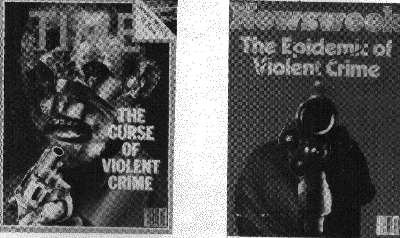
Time and Newsweek ran identical cover stories
the week before the shooting of Reagan.
These lead stories, embodying our own growing violence, contained what must have been the highest percentage of violent imagery ever published in a lead newsweekly story. The fantasy words used in the articles contained virtually nothing but a long string of violent images, such as the opening of the Time article, which read "crime... murder... raped... violence... crime... killing, robbing, raping and assaulting..." and so on, for page after page of extraordinarily frightening imagery, focused mainly on handguns.
That these scare stories on a wildly "out of control" crime wave were actually based on figures as fictitious as those of our supposedly "out of control" economy is more difficult to believe, so successful has the media been in recent years in claiming a dramatic increase in major crime in America. Yet the most careful studies, those by the National Council on Crime and Delinquency, actually show slight decreases in the incidence of and in arrests for major crimes in recent years, concluding that "criminal behavior remains roughly constant over the years, and that 'crime waves' are created by the human imagination. "(28) Once
REAGAN'S AMERICA
|
On to page
|
To report errors in this electronic
transcription please contact:
[email protected]